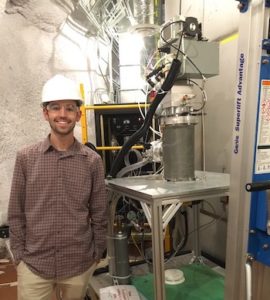 While at Brown I did particle astrophysics research with the LUX-ZEPLIN (LZ) dark matter detection collaboration. LZ is a huge detector filled with highly purified liquid xenon a mile underground at the Sanford Underground Research Facility (SURF) in Lead, SD. Launching in 2020, it will surpass its predecessor, LUX, as the most sensitive dark matter detector in the world. Dark matter is the moniker for the culprit behind a wealth of evidence for extra mass in the universe that doesn’t interact electromagnetically. We may not be able to see it, but we can see its gravitational effects on visible matter. According to the most recent Planck collaboration results, dark matter comprises 84% of all the mass in the universe (source). My main role within the collaboration was an analysis effort to pick up a theoretical directional anisotropy in the light signals given off by nuclear recoils, one that would allow for greater discrimination power in searching for a dark matter signature. This work culminated in my senior thesis, which can be found in the media page, along with a research paper that is still in development. To the left is a picture of me standing next to the neutron generator we used to produce the nuclear recoils during the summer of 2016.
While at Brown I did particle astrophysics research with the LUX-ZEPLIN (LZ) dark matter detection collaboration. LZ is a huge detector filled with highly purified liquid xenon a mile underground at the Sanford Underground Research Facility (SURF) in Lead, SD. Launching in 2020, it will surpass its predecessor, LUX, as the most sensitive dark matter detector in the world. Dark matter is the moniker for the culprit behind a wealth of evidence for extra mass in the universe that doesn’t interact electromagnetically. We may not be able to see it, but we can see its gravitational effects on visible matter. According to the most recent Planck collaboration results, dark matter comprises 84% of all the mass in the universe (source). My main role within the collaboration was an analysis effort to pick up a theoretical directional anisotropy in the light signals given off by nuclear recoils, one that would allow for greater discrimination power in searching for a dark matter signature. This work culminated in my senior thesis, which can be found in the media page, along with a research paper that is still in development. To the left is a picture of me standing next to the neutron generator we used to produce the nuclear recoils during the summer of 2016.